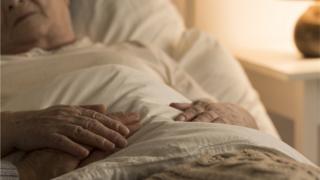 Image copyright Getty Images
Image copyright Getty Images Deaths of people in their own homes were still far above normal levels in July despite non-Covid-19 deaths falling to below-average levels in hospitals and care homes, figures show.
The Office for National Statistics says patients in England and Wales may not be being admitted to hospital or they are discharged earlier than usual.
People in older age groups may also be choosing to die at home.
Non-Covid deaths have been reducing since May, after peaking in April.
This is particularly true for the over-80s, who saw the biggest rise in deaths around the peak of the pandemic.
The ONS analysis suggests this may be due to a displacement effect caused by the virus, which results in deaths happening earlier than expected in some age groups.
In hospitals, deaths for non-coronavirus reasons fell sharply from the start of April while rising in care homes and private homes.
READ RELATED: 'Sobering tents' will be used for 'drunk and disorderly fans' at the 2022 World Cup in Qatar
Since then, non-Covid deaths in hospitals have gone up but are still much lower than normal, the ONS says.
There were nearly 14,000 non-Covid deaths in hospitals in England and Wales between May and mid-July.
What people are dying from has also fluctuated.
Dementia, Alzheimer’s disease and chronic lower respiratory diseases – the main causes of death which went up between March and May – have returned to normal levels.
But some underlying causes of death are still higher than usual, such as those involving diabetes, hypertensive diseases and several heart-related conditions.
Although deaths for these reasons have been coming down in recent weeks, these diseases are killing more people than normal.
This could be linked to delays in people accessing care, either because treatment has not been available or because they have been put off going to seek medical help.
Source: BBC News – Health









